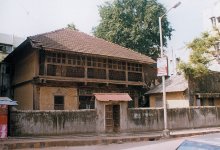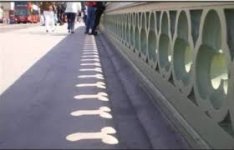OK, anything less that 1 in 4 is considered flat. My beef is with the REALLY flat roofs. The problem with flat roofs is some idiots actually build them FLAT. All it takes is a few degrees easily hidden by the curb. This prevents standing water which will always find a way in. Sure, modern materials are better than tar and cardboard, but you are still fighting mother nature. She always wins. Another really stupid mistake is to rely on drains in the center of the roof. They WILL clog and leave you with a lot of water on the roof Again, just a little slope to the outside and you avoid all these issues. Then some idiot invented the butterfly roof and the builder actually made the center level.
I have owned two houses that had flat roofs. Never again. Even a modern membrane roof covering will fail because it does depend on installation and there are always perforations for vent stacks and drains that can fail. It is just not logical to design a roof that does not naturally shed rain. Water is the most destructive natural element for houses. Sloped roofs with clay tile or slate shingles will last 100 years or more, with virtually no maintenance.
Even a thatched roof in rainy Britain lasts at least 25 years using wheat reed and with water reed at least 40-50 years.
Yeah, there were wind-induced resonances involved, but the end result was still 500 lb panes popping out of a high-rise. The replacement plywood was a low-rent touch - I remember it well in my early years at MIT, as the Hancock tower was pretty much right across the river from my end of campus.
Yes, inspecting and consulting. My roofing days are long behind me.ah Cal you're in the roofing business I see 🙂
In Canada 4:12 and less is considered 'low slope' and is usually treated as waterproofing rather than watershedding if that's what you mean.OK, anything less that 1 in 4 is considered flat.
This is more than a little impractical for large roofs. Properly placed drains, in cricketed valleys is the norm. Drain clogging is a result of neglect, designers can't change that.Another really stupid mistake is to rely on drains in the center of the roof. They WILL clog and leave you with a lot of water on the roof Again, just a little slope to the outside and you avoid all these issues.
Here we refer to manufacturer's warranties as toilet paper.do it right and even the membrane manufacturer will warrant this for 30years+.
A blanket statement that indicates you have had bad luck, nothing more.Even a modern membrane roof covering will fail because it does depend on installation and there are always perforations for vent stacks and drains that can fail.
You're partly right but wind, snow, fire, bird droppings and falling debris might want to argue.It is just not logical to design a roof that does not naturally shed rain. Water is the most destructive natural element for houses.
Whoah. I'll just leave that one alone. Too much to deal with in this thread.Sloped roofs with clay tile or slate shingles will last 100 years or more, with virtually no maintenance.
I'm sorry - isn't that the very definition of "Architect" ?Insufficient design / relying solely on workmanship to cover-up design problems is where the failures come from.
Yes, clay tiles almost never leaks and protects homes. Keeps the inside cool in summer too.<snip> It is just not logical to design a roof that does not naturally shed rain. Water is the most destructive natural element for houses. Sloped roofs with clay tile or slate shingles will last 100 years or more, with virtually no maintenance.


First building is 139 years old, second one is approximately 60 years old. Due to surge in real estate prices only these two homes have survived in my hometown.
Regards.
They've been replacing the roof on the Empress and its about a 100 years +.Sloped roofs with clay tile or slate shingles will last 100 years or more, with virtually no maintenance.
Whoah. I'll just leave that one alone. Too much to deal with in this thread.
What really is neat is the new shiny copper down spouts replacing the old ones.😀

Last edited:
I'm sorry - isn't that the very definition of "Architect" ?
Not round here it isn't!
There was a tower at Birmingham University with similar problems. It was so ugly that it won an architecture award. It was ugly inside too: narrow concrete corridors and odd shaped rooms. It was continually covered in scaffolding while it was being 'refurbished'; partly to deal with the sheets of glass which kept dropping from the windows.wrenchone said:Yeah, there were wind-induced resonances involved, but the end result was still 500 lb panes popping out of a high-rise. The replacement plywood was a low-rent touch - I remember it well in my early years at MIT, as the Hancock tower was pretty much right across the river from my end of campus.
There is an ugly building near me, in the grounds of a school. It looks completely out of place in its setting. It too has won an award. Unsurprisingly, perhaps, a friend of mine who is a professional structural engineer thinks it is a wonderful building!
Similar thing happened with the Radisson Blu Hotel on Holloway Circus in Birmingham City centre.
For over a year after they built it it was shedding sheets of glass on to the pavement below on a regular basis seemingly unrelated to weather conditions.
The scaffolding disappeared and a week later it was back to protect pedestrians after falling glass nearly killed someone.
For over a year after they built it it was shedding sheets of glass on to the pavement below on a regular basis seemingly unrelated to weather conditions.
The scaffolding disappeared and a week later it was back to protect pedestrians after falling glass nearly killed someone.
I hope Mark isn't looking in. 😉
Architects can stand some teasing, they deserve it. 😛Not round here it isn't!
That's another architect who didn't bother to do sunlight ray tracing! And in London too, if I'm not mistaken?
I would think that Big Ben, at the other side of the bridge, counts as a phallic symbol too.
(aah, but then there's Blackfriars,as good as dick as any. Oh no, I almost skipped the spickled Gherkin, the giant love for business toy)
(aah, but then there's Blackfriars,as good as dick as any. Oh no, I almost skipped the spickled Gherkin, the giant love for business toy)
The whole 'world's tallest building' thing is just a hugely expensive dick-measuring contest.
Especially taking into account the un-usable space which is just there to get the top a bit higher than the other guys.
Especially taking into account the un-usable space which is just there to get the top a bit higher than the other guys.
The smaller the man, the taller the building (or so it appears)
Global average size maps might be interesting, for a 1-on-1 comparison.
Global average size maps might be interesting, for a 1-on-1 comparison.

- Status
- Not open for further replies.
- Home
- Member Areas
- The Lounge
- architects forget physics


